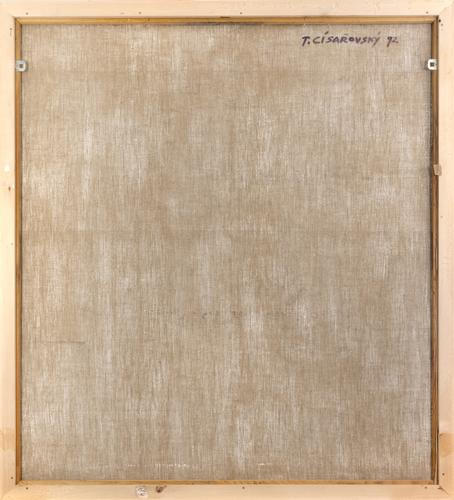



Oil on canvas
160 × 145 cm
Signed on the reverse of the canvas T. Císařovský 92
Dostál M., Tomáš Císařovský, Praha: KANT, 2003.
Tomáš Císařovský entered the Czech art scene in the mid-1980s as a pure painter. At that time, he participated in the unofficial student exhibitions Konfrontace (Confrontations), presenting paintings close to the Italian Transavanguardia, which influenced the young emerging generation with its spontaneous and purely visual way of creating. At the turn of the eighties and nineties, Císařovský, together with the circle of artists around the group Tvrdohlaví (The Stubborn Ones), moved towards a postmodern expression. The well-known cycle of paintings from this period, titled Z deníku dědy legionáře (From the Diary of a Legionary Grandfather), is from this time, connecting a personal family story with the collective history of a certain segment of Czech history. The intermingling of personal motifs with more general themes of Czech society, its history, identity, and transformation against the background of momentous historical events became characteristic of Tomáš Císařovský's painting in the following period as well.
In the early nineties, alongside his postmodern orientation, Císařovský developed an artistic style that is characteristic of his subsequent work. The author places great emphasis on the chosen color scale of his paintings, which are either harmonious or contrasting and simultaneously carry the meaningful and symbolic message of the image. The oil painting technique, supplemented in later years by washed-out watercolor painting, brings to the foreground figural scenes of levitating figures in an empty, abstract, and entirely painterly space. The smooth illusionistic painting simultaneously contains a tension between reality and its symbolic meanings. The gestures of the hands, bodies, and faces of the human protagonists carry important messages, which are more distinct and evident thanks to the absence of any environment that would disrupt or obscure their meanings.
The series of paintings titled Budování kapitalismu v Čechách (Building Capitalism in Bohemia) from 1992–1993, which playfully reacted to the contemporary political and social situation of the early nineties, was created in this spirit. The offered painting, titled Kolmost (Perpendicularity) from 1993, forms a pendant to the painting Šířka (Width) from the same year. In both, the figure of a young man appears in a slightly ill-fitting suit—a contemporary novice entrepreneur who seized the opportunity to build and create a new capitalist society based on individual success. Císařovský does not capture the opportunity for self-realization and capital creation critically; nevertheless, a certain humor and irony are conveyed in the paintings by the enlarged Lego bricks, which become the building blocks and the measure of achieved profits. The principle of a children's game in the hands of adults ceases to be an innocent construction of blocks; its stability can be just as uncertain. The building of capitalism is presented here as a trial-and-error experiment, a path that needs to be tried without prior experience. But is our society prepared for this path, and will it be built correctly?
Tomáš Císařovský studied at the Academy of Fine Arts in Prague (AVU) from 1983–1988 under the guidance of Arnošt Paderlík. Since 1984, he participated in the student unofficial exhibitions Konfrontace, which brought an interest in contemporary European Neo-Expressionist painting to the Czech environment. In the nineties, he became a core artist of the Prague gallery MXM, which represented the young painting generation and presented postmodern creation. Since the nineties, Císařovský has regularly exhibited in solo and group exhibitions in Czech and international galleries. His work is represented in significant institutional and private collections.
#25025525


